AGA KHAN PROGRAM FOR ISLAMIC ARCHITECTURE
Course 4.611/4.613:
11- The Medieval Palace of Justice (Dar al-‘Adl): (Click on images to enlarge)
Dar al-‘Adl, or the Palace of Justice:
A unique Islamic institutional structure that served as a symbol of justice and the rulers faith and commitment to defend Islam during the period of Crusader and Mongol attacks. Its earliest example appears to have been built around the year 1160 in Damascus, and the last in 1335 at the Cairo Citadel. All in all, seven palaces of justice are known to have existed in Damascus, Aleppo, and Cairo, but they have all disappeared.
The Dar al-‘Adl of Damascus:
Built by Nur al-Din Mahmud ibn Zanki (1146-74) and named the dar al-‘adl or dar kashf al-mazalim (house of justice or of mazalim's inquest) around 1163. It occupied a block south of the citadel, across the street from its southern postern. It was a grand qa‘a which had an iwan where the court sessions were convened.
Plan of Damascus in 13th century showing the citadel in the upper left-hand corner |
The location of the dar al-'Adl within the Dar-al-Sa'ada south of the citadel |
The Dar al-‘Adl of Aleppo:
Built by the Ayyubid al-Zahir Ghazi (1186-1216), the son of Salah al-Din south of the Citadel, which was being refurbished at the same time. Dar al-‘Adl was a separate structure enclosed between two parallel city walls and joined to the citadel by a direct passage.
Map of Aleppo in the 13th century showing the citadel at the western end of the city |
Schematic drawing showing the proposed location of dar al-'Adl of Aleppo south of Citadel |
The 5 Dur al-‘Adl of Cairo:
- Dar al-‘Adl al-Kamiliyya: located in the narrow end of the northern enclosure of the Citadel. It probably belonged to the first stage in the construction of the Citadel's administrative section.
- Dar al-‘Adl al-Zahiriyya: The second Cairene Dar al-‘Adl built by the Mamluk sultan al-Zahir Baybars as a fenced, square mastaba (platform) installed in the middle of the court in front of the Citadel gate and covered by a canopy.
- The Iwan al-Mansuri: built in 1284 by Sultan Qalawun.
- The Iwan al-Ashrafi: al-Ashraf Khalil (1290-94) rebuilt by Ashraf Khalil, or perhaps only refurbished, and renamed after him.
Plan of the Cairo in the 13th century showing the citadel location in comparison to the urban areas |
A schematic drawing showing the location of the first 4 dur al-'Adl of Cairo |
- The Iwan al-Kabir al-Nasiri: Al-Nasir Muhammad demolished the iwan of his brother Khalil and built a new one in 1311. The Iwan was a monumental stone structure with typical basilical plan modified by opening the sides to provide an unobstructed view to the outside and to suggest the accessibility of the sultan sitting within. The wide, central aisle was surmounted by a huge wooden dome covered on the outside with green tiles and flanked by two lateral aisles formed by rows of red granite columns, which were taken from ancient Egyptian temples. The order of seating in dar al-‘adl sessions seems to have matched almost exactly the plan of the Great Iwan.
Depictions of the Great Iwan al-Nasiri as it stood around 1800 from the Description de l'Egypte |
Depictions of the Great Iwan al-Nasiri as it stood around 1800 from the Description de l'Egypte |
Plan of the Iwan al-Kabir al-Nasiri after the Desciption de l'Egypte |
15th century Italian sketch showing the sultan on his dais during the reception at the Iwan al-Kabir |
Schematic of the sultan's position in dar al-'Adl |
Schematic of the circle forming around the sultan in dar al-'Adl |
Schematic of the great emir's position in dar al-'Adl |
The final seating arrangement around the sultan in dar al-'Adl |
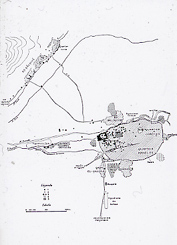
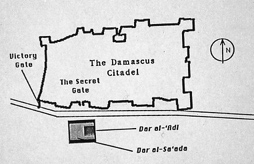
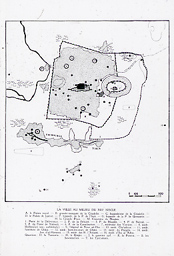
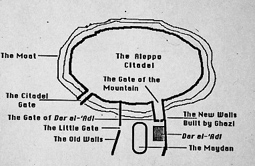
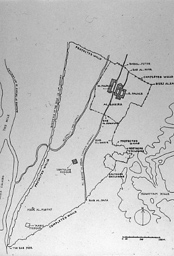
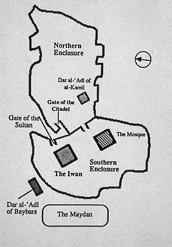
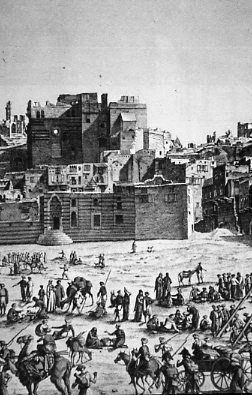
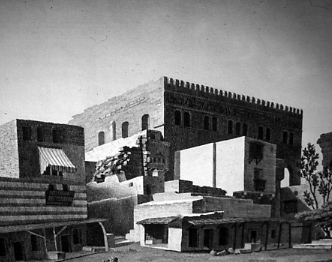

 A
A


